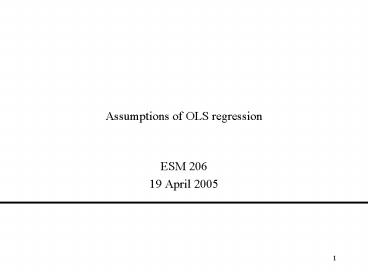Assumptions of OLS regression - PowerPoint PPT Presentation
1 / 26
Title:
Assumptions of OLS regression
Description:
Re-frame the model. Use nonlinear least squares (NLS) regression. 4 ... If not, try adding additional terms (e.g., quadratic) 19 ... – PowerPoint PPT presentation
Number of Views:946
Avg rating:3.0/5.0
Title: Assumptions of OLS regression
1
Assumptions of OLS regression
- ESM 206
- 19 April 2005
2
Assumptions of OLS regression
- Model is linear in parameters
- The residuals are normally distributed
- The residuals have constant variance
- The expected value of the residuals is always
zero - The residuals are independent from one another
- The X values are precise
- The independent variables are not too strongly
collinear
- If these assumptions are satisfied, then OLS
estimator is unbiased and has minimum variance of
all unbiased estimators. - How can we test these assumptions?
- If assumptions are violated,
- what does this do to our conclusions?
- how do we fix the problem?
3
Model not linear in parameters
- Problem Cant fit the model!
- Diagnosis Look at the model
- Solutions
- Re-frame the model
- Use nonlinear least squares (NLS) regression
4
Residuals not normally distributed
- Problem
- Parameter estimates are unbiased
- P-values are unreliable
- Regression fits the mean with skewed residuals
the mean is not a good measure of central
tendency - Diagnosis examine QQ plot of Studentized
residuals - Corrects for bias in estimates of residual
variance
5
(No Transcript)
6
Residuals not normally distributed
- Problem
- Parameter estimates are unbiased
- P-values are unreliable
- Regression fits the mean with skewed residuals
the mean is not a good measure of central
tendency - Diagnosis examine QQ plot of Studentized
residuals - Corrects for bias in estimates of residual
variance
- Solutions
- Transform the dependent variable
- May create nonlinearity in the model
7
Try transforming the response variable
Box-Cox Transformations
8
But weve introduced nonlinearity
Actual by Predicted Plot (Chlorophyll)
Actual by Predicted Plot (sqrtChlorophyll)
9
Residuals not normally distributed
- Problem
- Parameter estimates are unbiased
- P-values are unreliable
- Regression fits the mean with skewed residuals
the mean is not a good measure of central
tendency - Diagnosis examine QQ plot of Studentized
residuals - Corrects for bias in estimates of residual
variance
- Solutions
- Transform the dependent variable
- May create nonlinearity in the model
- Fit a generalized linear model (GLM)
- Allows us to assume the residuals follow a
different distribution (binomial, gamma, etc.)
10
Residuals have non-constant variance
(heteroskedasticity)
- Problem
- Parameter estimates are unbiased
- P-values are unreliable
- Diagnosis plot studentized residuals against
fitted values
11
(No Transcript)
12
Residuals have non-constant variance
(heteroskedasticity)
- Problem
- Parameter estimates are unbiased
- P-values are unreliable
- Diagnosis plot studentized residuals against
fitted values
- Solutions
- Transform the dependent variable
- May create nonlinearity in the model
13
Try our square root transform
14
(No Transcript)
15
Residuals have non-constant variance
(heteroskedasticity)
- Problem
- Parameter estimates are unbiased
- P-values are unreliable
- Diagnosis plot studentized residuals against
fitted values
- Solutions
- Transform the dependent variable
- May create nonlinearity in the model
- Fit a generalized linear model (GLM)
- For some distributions, the variance changes with
the mean in predictable ways - Fit a weighted least squares regression (WLS)
- Also good when data points have differing amount
of precision
16
Average error not everywhere zero (nonlinearity)
- Problem indicates that model is wrong
- Diagnosis look for curvature in
componentresidual plots (CR plots also
partial-residual plots)
17
(No Transcript)
18
Average error not everywhere zero (nonlinearity)
- Problem indicates that model is wrong
- Diagnosis look for curvature in
componentresidual plots (CR plots also
partial-residual plots)
- Solutions
- If pattern is monotonic, try transforming
independent variable - If not, try adding additional terms (e.g.,
quadratic)
19
Residuals not independent (autocorrelation)
- Problem parameter estimates are biased
- Diagnosis look at autocorrelation function to
find patterns in - time
- space
- sample number
- Solutions fit model using generalized least
squares (GLS)
20
X-values not precise (measurement error)
- Problem parameter estimates are biased
- Diagnosis know how your data were collected!
- Solution very hard
- State space models
- Restricted maximum likelihood (REML)
- Use simulations to estimate bias
- Consult a professional!
21
Independent variables are collinear
- Problem parameter estimates are imprecise
- Diagnosis
- Look for correlations among independent variables
- In regression output, none of the individual
terms are significant, even though the model as a
whole is
- Solutions
- Live with it
- Remove statistically redundant variables
22
Summary of OLS assumptions
23
What can we do about chlorophyll regression?
- Square root transform helps a little with
non-normality and a lot with heteroskedasticity
- But it creates nonlinearity
24
A new model its linear
25
its normal (sort of) and homoskedastic
26
and it fits well!































